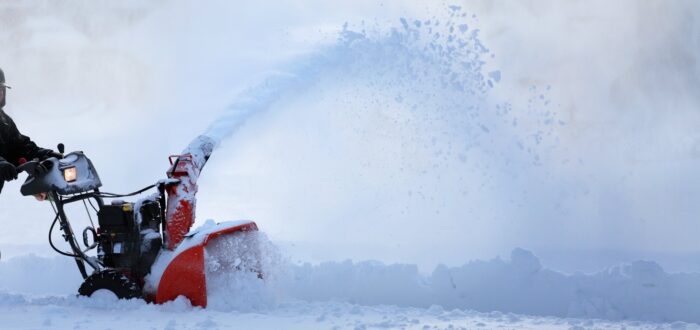While you may think you’re ready for winter, it’s never too early to check your snowblower. Snow blowers can be pretty complicated machines. It may be on the verge of breaking down because they have many moving parts. Having a few tricks on hand in case you encounter one of these common snowblower problems will save you a trip to the repair shop.
These tips are perfect for snowblower users of all skill levels, from clearing clogs to making sure your auger is working properly!
Problem #1: Snow is frozen in your snow chute
What you need: A broom or blow dryer, and a towel or shop cloth
What to do: Use the towel or shop cloth to remove as much snow as possible from the snow chute. If there’s too much ice built up for this method to work, use your broom handle to loosen as much snow as you can, then use your snowblower nozzle to remove any remaining snow.
Don’t do this: Never use a fire poker or other sharp metal objects in your snow chute, as this will only damage the inside of the snowblower over time.
Problem #2: There is snow stuck in your auger housing
What you need: A stick or dowel that fits into the snow chute opening. A drop cloth is optional but will help prevent snow from flying everywhere while you’re poking around with your stick or dowel.
What to do: Insert your stick down one side of the chute and work it back and forth until the snow begins to move freely (you may need to poke deeper). Use this method to remove snow from the top and the bottom of your snow chute.
Don’t do this: Never insert a sharp metal object (like a screwdriver) into your snowblower. The metal can damage your gears and blades, plus there’s always the risk you’ll accidentally cut yourself!
Problem #3: There is snow stuck in between your auger housing and chute opening
What you need: A broom or shop vacuum hose with a wand attachment that has an angled nozzle end
What to do: Use your broom or wand attachment to remove any snow that’s built up around the front of your snowblower’s snow chute and auger area. Be careful not to hit anything with the snow or your snowblower’s body.
Don’t do this: Never use the snowblower nozzle to remove snow from between the chute and auger. This can damage the area.
Problem #4: Your snow blower is smoking or making a weird noise
What you need: WD-40, an adjustable wrench or crescent wrench, screwdriver or flat head nail file (these are usually handy), replacement shear pin, and a roll of duct tape
What to do: Locate the spot where your snowblower is collecting snow, and apply WD-40 to prevent it from happening in the future. Make sure you wear protective gloves when applying WD-40, and try not to get any on yourself or other exposed areas. If snow continues to collect in the same area, you may still have a leak.
Make sure your snowblower is clear of snow and debris before starting it up for the first time this winter! Open up the engine compartment and check for any snow or leaves that may have gotten into your blower. Use a screwdriver or nail file to remove anything blocking airflow directly from the auger housing. If there’s a lot of snow buildup on top of your snowblower, use a broom or shop vacuum with an angled nozzle attachment to knock off as much as possible before you start it up.
Don’t do this: Never run your snowblower with a significant amount of snow or leaves still trapped inside your snow chute. This can cause snow to blow out of your snowblower uncontrollably and make things worse. For example, you may cause snow to blow into the pathway you’re trying to clean, or snow may fly around instead of being pulled through by the auger.
Problem #5: Your snowblower’s engine won’t start because there’s too much snow in your carburetor or fuel line
What you need: WD-40, an adjustable wrench or crescent wrench, screwdriver or flat head nail file,, replacement shear pin, and a roll of duct tape
What to do: Locate the spot where snow has collected in your snowblower, for example, if snow is blocking airflow, or snow is blowing into the engine compartment. Use your broom or shop vac with an angled nozzle attachment to remove as much snow as possible before you start your snowblower for the first time this winter. If there’s too much snow built up around the carburetor or fuel line, spray WD-40 on the spot where snow is collecting. Be careful not to get any yourself or in other areas.
Don’t do this: Never run your snowblower without clearing out any potential snow problems beforehand. Snow buildup can cause major damage if left alone too long. Even just a small amount of snow in the wrong place can block off flow completely and prevent your engine from starting up.
Having a basic knowledge of how to troubleshoot common snowblower problems can save you time and money. If you do need professional help with your snowblower or other small engines, we at Greg’s Small Engine Service and Repair will be more than happy to assist you.






















